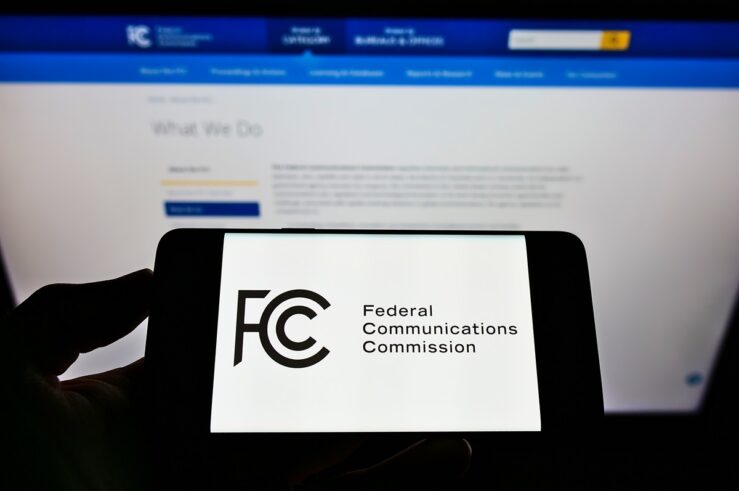
The Federal Communications Commission’s (FCC) recently enacted rules to prevent so-called “digital discrimination” in broadband access are facing a significant legal challenge in the 8th U.S. Circuit Court of Appeals. Earlier this week, the U.S. Justice Department and the FCC submitted their brief on the matter. Now that the parties have made their “opening arguments” in the case, let’s look at the key issues in dispute. They include the scope of the FCC’s authority, interpretation of congressional mandates, and the balance between promoting equal access to broadband and preserving market incentives for broadband deployment.
Statutory Interpretation of Section 60506
At the heart of this case is the FCC’s interpretation of Section 60506 of the Infrastructure Investment and Jobs Act (IIJA). This provision directs the commission to adopt rules “preventing digital discrimination of access based on income level, race, ethnicity, color, religion, or national origin.”
The FCC interprets this language as authorizing rules that prohibit not only intentional discrimination, but also practices with unjustified discriminatory effects—better known as “disparate impact.” It argues that the statutory focus on “equal opportunity to subscribe” indicates that Congress was concerned with policies’ effects, not just intentional discrimination.
Opponents of the rules—led by the Minnesota Telecom Alliance and known as the “Industry Petitioners”—contend that the statutory language, particularly the phrase “based on,” only authorizes rules against intentional discrimination. They argue that if Congress had intended to allow disparate-impact claims, it would have used language similar to other civil-rights statutes that courts have interpreted to allow such claims.
Consistency with Supreme Court Precedent
The FCC’s framework for investigating disparate-impact complaints is also under scrutiny. The industry petitioners argue that the FCC’s approach departs from the burden-shifting framework established by the Supreme Court in cases like Texas Department of Housing and Community Affairs v. Inclusive Communities Project. The FCC counters that its framework is consistent with Supreme Court precedent, allowing defendants to justify practices based on technical or economic feasibility.
Under Inclusive Communities:
- Plaintiffs have the initial burden to establish evidence that a policy or practice caused a disparate impact on a protected class;
- The defendant can counter the plaintiffs’ prima facie showing by establishing that the challenged policy or decision is “necessary to achieve a valid interest”; and
- The defendant’s “valid interest” will stand unless the “plaintiff has shown that there is an available alternative practice that has less disparate impact and serves the entity’s legitimate needs.”
The FCC’s approach echoes Inclusive Communities, but differs in some significant ways:
- The commission will determine the nature of an alleged disparate impact and determine whether the identified policy or practice is causing the disparate impact.
- “[T]he entity under investigation will have the burden of proving to the Commission that the … practice in question is justified” by “genuine issues of technical and economic feasibility.” The FCC’s report and order clearly states that the agency does not consider profitability a “genuine issue,” indicating “we weigh profitability separately from technical or economic feasibility.”
- The commission will determine whether a less-discriminatory alternative policy or practice is reasonably available and achievable and identify any such alternative. If so, then that policy or practice “will not be deemed justified by genuine issues of technical or economic feasibility.”
The industry petitioners contend that the FCC’s approach places an undue burden on defendants to prove the absence of less-discriminatory alternatives. In particular, the FCC’s rules place a high burden on entities to demonstrate “genuine” issues of technical and economic feasibility, and a lower burden on the commission to identify a less-discriminatory alternative policy or practice.
Scope of Covered Entities
Another point of contention is whether the FCC can apply its rules to entities other than broadband providers. The commission’s rules cover not only internet service providers (ISPs), but also other entities that could affect access to broadband services. As noted in an amicus brief submitted by the International Center for Law & Economics (ICLE) and the Information Technology & Innovation Foundation (ITIF), the commission defines a “covered entity” to include “[e]ntities that otherwise affect consumer access to broadband internet access service,” which would include state and local governments and nonprofits, as well as multi-family housing owners, many of whom may have no idea they are subject to the FCC’s digital-discrimination rules, nor any idea of how to comply with the rules.
The industry petitioners argue that Section 60506 only authorizes rules for broadband providers. The FCC, however, contends that in defining “equal access” as the “equal opportunity to subscribe,” the statutory text allows the agency to reach other entities whose conduct may impede equal access to broadband.
Enforcement Authority
The FCC claims authority to use its complete “enforcement toolkit,” including monetary forfeitures, to implement the digital-discrimination rules. The industry petitioners argue that Section 60506 does not authorize such penalties and that the FCC’s enforcement authority should be limited to forward-looking remedies like cease-and-desist orders.
Major Questions Doctrine
The industry petitioners and amici argue that the FCC’s rules raise “major questions” of economic and political significance, requiring clearer congressional authorization than Section 60506 provides. The FCC maintains that Congress provided clear authorization for its approach and that the rules do not trigger the major questions doctrine.
The industry petitioners argue that the FCC’s rules have vast economic and political significance. The broadband industry alone is valued at $112 billion, with more than 125 million customers. The rules would affect not just ISPs but potentially a wide range of entities that could “otherwise affect consumer access to broadband.” Moreover, they contend that the FCC is claiming dramatic new powers over broadband deployment and essentially setting up a system for generalized civil-rights claims. This, they argue, is unprecedented in the agency’s history.
More importantly, the petitioners argue that Section 60506 does not provide the “clear congressional authorization” required for such significant regulatory action. They point out that, if Congress had intended to authorize disparate-impact analysis, it could have used language similar to other civil-rights statutes that courts have interpreted to allow such claims.
In contrast, the FCC contends that Section 60506 clearly mandates adopting rules “preventing digital discrimination of access.” It argues that this legislative command is unmistakable and specific, unlike the vague or ancillary provisions at issue in other major questions cases. In addition, the FCC claims that its longstanding mission has included ensuring nondiscriminatory access to communications services. Extending these goals to combat digital discrimination does not substantially overhaul its enforcement mission. The agency further notes that many providers are already familiar with disparate-impact standards from other contexts. Thus, the FCC claims that its approach presents no significant additional burden.
While the FCC disclaims rate-regulation authority, the industry petitioners argue that the rules effectively allow the FCC to control pricing through its authority to ensure “pricing consistency” and by potentially demanding higher service quality under “comparable terms and conditions.” The agency counters that enforcing pricing consistency is not rate regulation and that its rules do not amount to, and will not lead to, rate regulation.
The dispute over the major questions doctrine is crucial because, if the court agrees with the industry petitioners that it applies, the FCC must show that Congress provided a clear statement authorizing such broad regulatory authority. Given the relatively brief and general language of Section 60506, this could be a high bar for the FCC to meet.
How Will This Play Out?
It’s always a fool’s errand guessing which way a court case will go, so consider this to be a fool’s best guess after reading through the briefs.
The short version: the FCC’s digital-discrimination rules appear to exceed the authority granted by Congress in Section 60506.
The statutory language of Section 60506 does not clearly authorize rules prohibiting practices with disparate impacts. The phrase “discrimination… based on” protected characteristics is more naturally read as prohibiting intentional discrimination, not practices with unintended discriminatory effects. If Congress had intended to authorize disparate-impact liability, it likely would have used language similar to that in other civil-rights statutes that courts have interpreted to allow such claims.
Moreover, the structure of the IIJA suggests a more limited role for Section 60506. The act includes other provisions specifically aimed at addressing broadband deployment in underserved areas (the Broadband Equity Access and Deployment Program, or “BEAD” program) and affordability for low-income households (the Affordable Connectivity Program). This context suggests that Section 60506 was intended to play a narrower role in preventing intentional discrimination, rather than serving as a broad mandate to address all disparities in broadband access.
The FCC’s expansive interpretation of its authority under Section 60506 also raises concerns under the major questions doctrine. The rules would give the commission sweeping authority over broadband-deployment decisions, including potential de facto control over pricing. Such a significant expansion of regulatory authority over a major sector of the economy requires clearer congressional authorization than Section 60506 provides.
Furthermore, the FCC’s framework for investigating disparate-impact claims departs from the burden-shifting approach established by the Supreme Court in cases like Inclusive Communities. The FCC risks chilling legitimate business decisions and investment in broadband deployment by placing a heavy burden on defendants to prove the absence of less-discriminatory alternatives.
The commission’s extension of its rules to entities other than broadband providers also appears to exceed its statutory authority. While the FCC’s desire to address all potential sources of discrimination is understandable, Section 60506 does not clearly authorize such a broad reach.
Regarding enforcement, while Section 60506 implicitly authorizes some enforcement mechanisms, it does not clearly grant the FCC authority to impose monetary forfeitures. The commission’s general enforcement authority under the Communications Act does not automatically extend to this new statutory provision.
If the court vacates the FCC’s digital-discrimination rules and remands for further proceedings, the court should direct the FCC to:
- Reconsider its interpretation of Section 60506, focusing on rules to prevent intentional discrimination by broadband providers in deployment decisions;
- Limit the scope of covered entities to broadband providers, as authorized by the statute;
- Reconsider its enforcement approach, focusing on forward-looking remedies clearly authorized by Section 60506; and
- Conduct a more thorough cost-benefit analysis, particularly considering potential negative impacts on broadband investment and deployment.
If the commission still believes disparate-impact liability is authorized, it should be directed to provide a more robust justification and ensure its investigative framework aligns more closely with Supreme Court precedent.
The FCC must take a more measured approach, balancing the goal of preventing discrimination with the need to preserve incentives for broadband deployment. It must also respect the limits of the authority granted by Congress, leaving broader policy decisions about addressing disparities in broadband access to the legislative branch.




